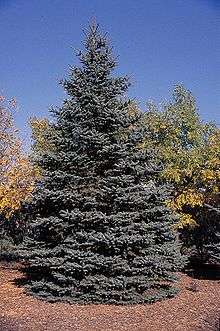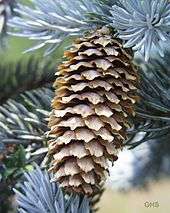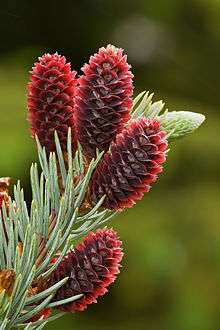Blue spruce
| Blue spruce Picea pungens | |
|---|---|
 | |
| Scientific classification | |
| Kingdom: | Plantae |
| Division: | Pinophyta |
| Class: | Pinopsida |
| Order: | Pinales |
| Family: | Pinaceae |
| Genus: | Picea |
| Species: | P. pungens |
| Binomial name | |
| Picea pungens Engelm. | |
 | |
The blue spruce, green spruce,[2] white spruce,[3] Colorado spruce, or Colorado blue spruce, with the scientific name Picea pungens, is a species of spruce tree. It is native to the Rocky Mountains of the United States. Its natural range extends from northern New Mexico to Wyoming, but it has been widely introduced elsewhere and is used as an ornamental tree in many places far beyond its native range. The blue spruce has blue coloured needles and is a coniferous tree.
Description
In the wild, Picea pungens grows to about 23 m (75 ft), but when planted in parks and gardens it seldom exceeds 15 m (49 ft) tall by 5 m (16 ft) wide. It is a columnar or conical evergreen conifer with densely growing horizontal branches. It has scaly grey bark on the trunk with yellowish-brown branches.
Waxy grey-green leaves, up to 3 cm (1 in) long, are arranged radially on the shoots which curve upwards. The pale brown cones are up to 10 cm (4 in) long.[4][5][6][7]
The specific epithet pungens means "sharply pointed", referring to the leaves.[8]
The blue spruce is the State Tree of Colorado.[9]
Cultivation
Picea pungens and its many cultivars are often grown as ornamental trees in gardens and parks.[5][6][10] It is also grown for the Christmas tree industry.[5]

Pests and diseases
The blue spruce is attacked by two species of Adelges, an aphid-like insect that causes galls to form. Nymphs of the pineapple gall adelgid form galls at the base of twigs which resemble miniature pineapples and those of the Cooley's spruce gall adelgid cause cone-shaped galls at the tips of branches. The larva of the spruce budworm eat the buds and growing shoots while the spruce needle miner hollows out the needles and makes them coalesce in a webbed mass. An elongated white scale insect, the pine needle scale feeds on the needles causing fluffy white patches on the twigs and aphids also suck sap from the needles and may cause them to fall and possibly dieback. Mites can also infest the blue spruce, especially in a dry summer, causing yellowing of the oldest needles.[11][12] Another insect pest is the spruce beetle (Dendroctonus rufipennis) which bores under the bark. It often first attacks trees which have blown over by the wind and when the larvae mature two years afterwards, a major outbreak occurs and vast numbers of beetles attack nearby standing trees.[13]
The blue spruce is susceptible to several needle casting diseases which cause the needles to turn yellow, mottled or brown before they fall off. Various rust diseases also affect the tree causing yellowing of the needles as well as needle fall. Canker caused by Cytospora attacks one of the lower branches first and progressively makes its way higher up the tree. The first symptom is the needles turning reddish-brown and falling off. Meanwhile, patches of white resin appear on the bark and the branch eventually dies.[11]
Cultivars
Common cultivars (those marked agm have gained the Royal Horticultural Society's Award of Garden Merit):-
- 'Glauca Globosa'agm[14] - shrub from 3–5 feet (0.91–1.52 m) in height[15]
- 'Fat Albert' - compact perfect cone to 10 feet (3.0 m) of a silver blue color[16]
- 'Glauca Jean's Dilly' - shrub from 3–6 feet (0.91–1.83 m) in height[17]
- 'Glauca Pendula' - drooping branches, spreads to about 8 feet (2.4 m) wide by 4 feet (1.2 m) tall[18]
- 'Hoopsii' agm[19]
- 'Koster'[20]
- 'Baby Blue Eyes'[21][22]
- 'Baby Blue' [23]
Uses
The Navajo and Keres Native Americans used this tree as a traditional medicinal plant and a ceremonial item, and twigs are given as gifts to bring good fortune. In traditional medicine, an infusion of the needles is used to treat colds and settle the stomach. This liquid is also used externally for rheumatic pains. Early people used their wood for building.[24]
Gallery
-

Mature cone
-

Immature cone
-

Hoopsii
-

Koster
-

Globosa
-

Montgomery
-

Fat Albert
See also
References
- ↑ A. Farjon (2011). "Picea pungens". IUCN Red List of Threatened Species. Version 2014.3. International Union for Conservation of Nature. Retrieved 10 December 2014.
- ↑ "Picea pungens: Blue Spruce, Colorado Blue Spruce, or Green Spruce (Pinaceae - Pine Family)".
- ↑ "Blue spruce, Picea pungens Engelm., Plant Symbol = PIPU" (PDF). USDA NRCS.
- ↑ RHS A-Z encyclopedia of garden plants. United Kingdom: Dorling Kindersley. 2008. p. 1136. ISBN 1405332964.
- 1 2 3 USDA Accessed 2012-12-01
- 1 2 Barnes, Burton V.; Warren J. Wagner Jr. (September 15, 1981). Michigan Trees: A Guide to the Trees of Michigan and the Great Lakes Region. Biological Science Series. University of Michigan Press. ISBN 978-0-472-08018-2.
- ↑ Vedel, H.; Lange, J. (1962). Trees and Bushes. Methuen & Co. pp. 119–120. ISBN 978-0416617801.
- ↑ Harrison, Lorraine (2012). RHS Latin for gardeners. United Kingdom: Mitchell Beazley. p. 224. ISBN 9781845337315.
- ↑ "State Trees & State Flowers". United States National Arboretum. June 11, 2009. Retrieved 2010-05-26.
- ↑ Conifers.org . accessed 1.12.2012
- 1 2 Gilman, Edward F.; Watson, Dennis G. (2011-05-01). "Picea pungens: Colorado Spruce". EDIS. IFAS Extension Service: University of Florida. Retrieved 2013-10-06.
- ↑ Cranshaw, W. S. (2013-06-13). "Scale Insects Affecting Conifers". Colorado State University Extension. Retrieved 2013-10-05.
- ↑ Ciesla, Bill (2013-04-19). "Spruce Beetle Threatens High Country Spruce Forests". Colorado State University Extension. Retrieved 2013-10-05.
- ↑ "RHS Plant Selector - Picea pungens 'Globosa'". Retrieved 27 May 2013.
- ↑ Missouri Botanical Garden: Picea pungens 'Glauca Globosa'
- ↑ Missouri Botanical Garden: Picea pungens Fat Albert
- ↑ Missouri Botanical Garden: Picea pungens 'Glauca Jean's Dilly'
- ↑ Fine Gardening Plant Guide: Picea pungens ‘Glauca Pendula'
- ↑ "RHS Plant Selector - Picea pungens 'Hoopsii'". Retrieved 27 May 2013.
- ↑ "RHS Plant Selector - Picea pungens 'Koster'". Retrieved 27 May 2013.
- ↑ "Missouri Botanical Garden - Picea pungens 'Baby Blueeyes'".
- ↑ "Washington State University - Picea pungens 'Baby Blueeyes'".
- ↑ "West Montrose Farms Ltd - Picea pungens 'Baby Blue'".
- ↑ U. Michigan-Dearborn: Ethnobotany Accessed 2012-12-01
External links
- USDA Plant Profile for Picea pungens (blue spruce)
- Conifers.org: Picea pungens (blue spruce) description
- Lady Bird Johnson Wildflower Center NPIN — Native Plant Information Network
- Interactive Distribution Map of Picea pungens
- Picea pungens — U.C. Photo Gallery
